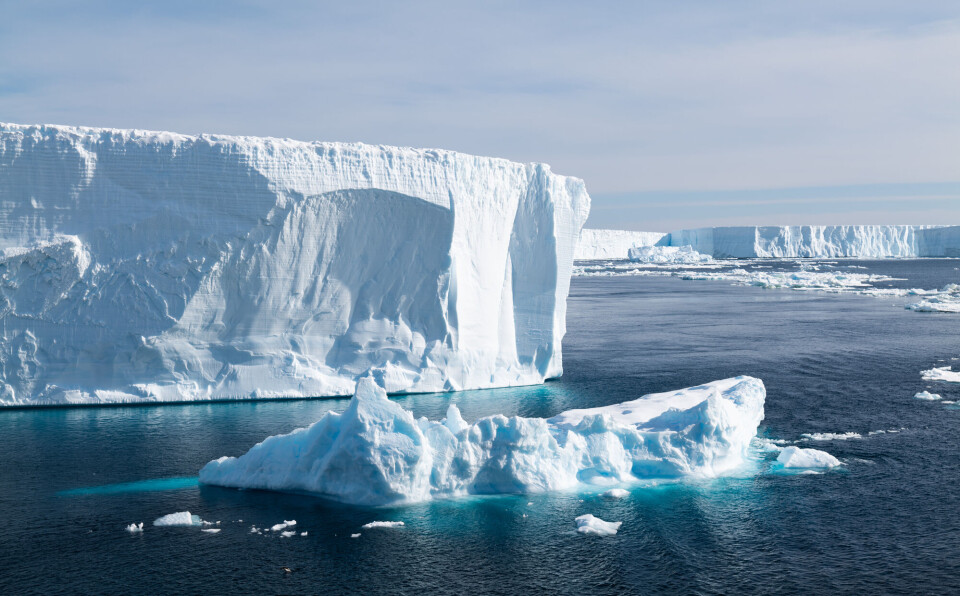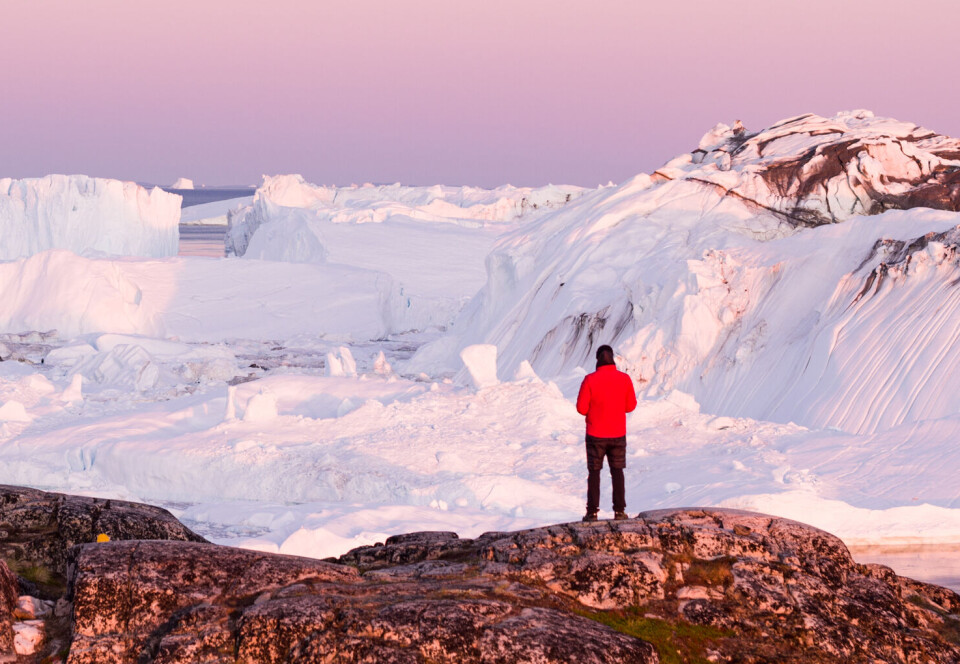
The ice in Antarctica has not yet reached a tipping point
But there are big differences between different parts of Antarctica.
Will the ice in West Antarctica soon reach a tipping point, or has the tipping point already been reached?
A climate tipping point is used to describe a natural system where conditions can change little by little until they reach a threshold. After that, the changes happen more quickly and on their own, even if the initial cause for the change is removed. The system is on its way to a new state.
In parts of Antarctica, researchers see that the ice is retreating. Is this because the melting has already reached a tipping point so that the ice will continue to keep melting no matter what we do?
The EU project TiPACCs, which is coordinated by NORCE, is investigating this exact question.
A little nudge
The researchers concluded that the ice has not yet reached a tipping point.
“The ice that is melting in the Amundsen Sea in West Antarctica isn’t melting because we have passed a tipping point, but because we have a climate that is too warm,” Petra Langebroek, who has led the project, says.
Langebroek is a researcher at NORCE and is associated with the University of Bergen’s Bjerknes Centre for Climate Research. NORCE is an independent research institute.
Langebroek and an international research team have investigated the state of Antarctica using state-of-the-art climate models.
They examined whether the melting that is now underway is reversible. They started by entering today’s climate into a climate model, and added a little extra pressure to the ice over 20 years.
This is a bit like pushing a ball and checking whether the push was strong enough to make it roll over an edge.
“We checked what happens if we push the ice just a little and add a little melting. When we take away the melting, does the ice continue to melt or does it return to its former state?” she says.
The bedrock matters
The researchers found that the melting that has happened to date is reversible. When they remove the warming, the ice grows again.
If today's climate had suddenly become colder, the melting could thus be reversed. In reality, however, there is no likelihood of the climate being colder anytime soon.
Whether or not the ice reaches a tipping point is not only determined by temperature.
In West Antarctica, much of the ice sheet rests on the bedrock far below the sea. The line where the wall of ice meets seawater is called the grounding line.
Ice shelves also extend from the ice wall, but they are not in contact with the bedrock, and float on the sea.
Both ice shelves and the grounding line have retreated in parts of West Antarctica. This is due to sea water temperatures.
How quickly the ice retreats depends on what the bedrock looks like.
The process could accelerate if the ice moves past a peak and starts descending downhill. The appearance and anchoring of the ice shelves are also significant factors, as they contribute to stabilising the ice sheet.

Both increases and decreases
“What’s the situation in Antarctica now?”
“It's a bit difficult to say. It depends on where you check,” Langebroek says.
“In parts of East Antarctica it will be a little warmer. That will cause more snow to fall, and parts of the ice sheet will grow. It will get a little thicker."
“In West Antarctica there is more melting, so there is less ice."
The amount of ice consequently increases or decreases on different areas of the continent.
“This makes it difficult to measure very precisely, but the latest measurements indicate that we are losing ice mass overall,” Langebroek says.

10,000 years later
Although the ice in West Antarctica has not yet reached a tipping point, it is likely to happen further into the future.
The researchers found that out when they modelled what would happen in Antarctica over 10,000 years, using today's climate as the starting point.
“If we simulate over a long period of time, the ice retreats more and then the tipping point in West Antarctica is crossed,” Langebroek says.
In West Antarctica by the Amundsen Sea, there are glaciers that researchers have long been concerned about.
This is especially true for Thwaites Glacier, also called the Doomsday Glacier, and the Pine Island Glacier.
The simulations showed that tipping points were reached in those locations.
The sea rose by three metres
Over the 10,000 year simulations, large parts of West Antarctica melted down, which meant the sea level would rise three metres.
“We have only modelled this with today's climate,” says Langebroek. “If it gets warmer, it will of course go faster.”
How much faster it goes with, for example, three degrees of global warming, is something that needs to be studied further, according to Langebroek.
In 3 out of 15 model runs, melting in the Amundsen Sea became irreversible after 300-500 years under today's climate. The different models had slightly different settings.
In other runs, this melting happened much later.
After the ice sheet reached the tipping point, it was not possible to stop the melting again, even if global temperatures had returned to pre-industrial levels.
“Irreversible is a difficult term. If we get a new ice age, it might be possible to stop it,” Langebroek says.
Will continue
The results of the studies are somewhat good news, says Langebroek. The melting is not irreversible.
On the other hand, the models show that melting in West Antarctica will continue, even under today's climate. But it's going slowly.
“For us and for our children, the melting will not stop,” she says.
Useful information
Heiko Goelzer is a researcher at NORCE and works with ice modelling in Antarctica and Greenland. He was not involved in the study.
Goelzer says that the two new studies are good and interesting. He thinks it’s good that the researchers used three different models in the first study. He thinks the finding that the ice has not yet reached a tipping point is robust.
“It’s useful. It tells us that the mass change we see today is unlikely to be due to a tipping point that has already been crossed,” he says.
Most viewed
Goelzer points out that this does not mean that we can rest easy on the fact that the ice in Antarctica is doing well.
The starting point for the studies is that the current climate will remain constant. In reality, warming is expected to increase.
“The ice will respond and is already responding,” he says.
Towards a new state
Goelzer says that in the second study, the ice is slowly moving towards multiple tipping points. Afterwards, the ice melting cannot be reversed. It will decrease until Antarctica reaches a new stable state.
“This is important. It shows that there are tipping points, and that some of them will eventually be reached, even without more warming,” he says.
With today's climate as a starting point, it will take a very long time before Antarctica reaches a new stable state. The melting will lead to a sea level rise of three metres because much of West Antarctica is melting.
“The ice sheet in West Antarctica is anchored below sea level. The ice mass is in contact with the sea. Most of this will disappear. Then the ice on land that is in direct contact with this ice will thin and vanish. Some ice on land in West Antarctica will remain," he says.
Happens very slowly
Goelzer points out that this will unfold over a very long time, if the current climate remains as it is now.
“It’s difficult to imagine 100 years into the future. And 10,000 years is beyond where I can think about what it means for society,” he says. “But the study says something about the processes that have already been set in motion, and which will eventually be set in motion, if we continue warming the planet."
How fast will the sea-level rise actually occur if it becomes two or three degrees warmer?
Goelzer says that a lot of research has been done on this, but that there are still great uncertainties.
We like to reduce climate to a number, to the global average temperature over pre-industrial times, he says.
“Of course, it’s much more complex than that. You have weather patterns that change naturally and in a chaotic manner. You have circulation and internal variation in the climate system,” he says.
Difficult to predict the future
How the climate and the ice will affect each other has a lot to say about what will happen. There’s uncertainty here.
“When the ice sheet begins to melt, the meltwater ends up in the sea. That changes ocean circulation and changes how heat accesses the ice. There is the potential for positive and negative feedbacks, which will either enhance the melting or dampen it,” he says.
It’s also possible to include hypothetical processes that have not yet been observed in Antarctica, but which may exist.
One of them is called marine ice cliff instability. This hypothesis says that when the ice shelves disappear, there will be a much more rapid retreat afterwards, because this will expose vertical cliffs that can collapse.
According to a 2019 special report on the ocean and cryosphere from the UN's climate panel, it is expected that melting in Antarctica will contribute to a sea-level rise of between 1 and 28 centimetres by 2100, depending on the scenario.
———
Translated by Nancy Bazilchuk.
Read the Norwegian version of this article at forskning.no
References:
Hill et al. The stability of present-day Antarctic grounding lines – Part 1: No indication of marine ice sheet instability in the current geometry, The Cryosphere, vol. 17, 2023. DOI: 10.5194/tc-17-3739-2023
Reese et al. The stability of present-day Antarctic grounding lines – Part 2: Onset of irreversible retreat of Amundsen Sea glaciers under current climate on centennial timescales cannot be excluded, The Cryosphere, vol. 17, 2023. DOI: 10.5194/tc-17-3761-2023






































